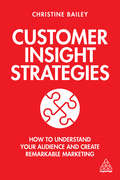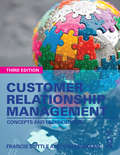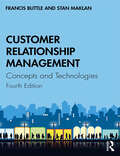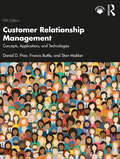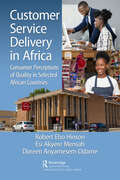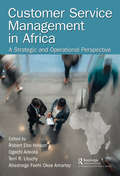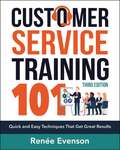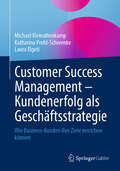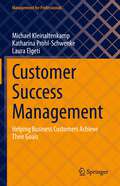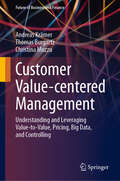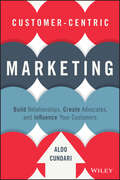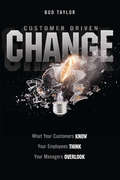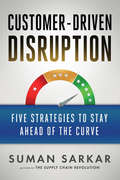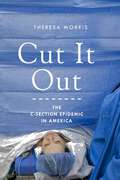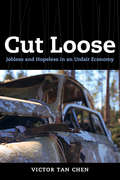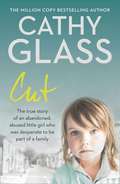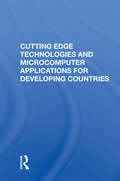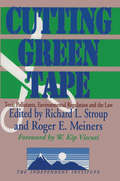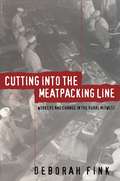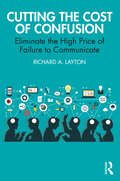- Table View
- List View
Customer Insight Strategies: How to Understand Your Audience and Create Remarkable Marketing
by Dr Christine BaileyIn a noisy, fast-paced marketing world, customer insight holds the key to creating memorable, purpose-driven marketing. Customer Insight Strategies outlines the critical role of customer insight and provides techniques and strategies that will help marketers identify trends, nurture leads and understand consumers - ultimately, empowering them to grow profits. The strategies are explained in a straightforward, jargon-free manner, and can be applied to a huge range of marketing challenges, regardless of time, budget or organizational size.Customer Insight Strategies shows precisely how customer insights can be used to build a mission with purpose. It discusses many of the core methods through which customer insight can be gleaned, providing easy-to-follow guidelines for applying them to everyday marketing practice. Covering topics such as customer segments, marketing to personas and lead generation, it contains global case studies from organizations including Cisco, NTT, Refinitiv and The Co-op as well as interviews with leading business professionals sharing their thoughts on using customer insights to grow profits. Written by a highly respected thought-leader and industry influencer, this book will help any professional create truly powerful marketing.
Customer Relationship Management: Concepts and Technologies
by Stan Maklan Francis ButtleCustomer Relationship Management Third Edition is a much-anticipated update of a bestselling textbook, including substantial revisions to bring its coverage up to date with the very latest in CRM practice. The book introduces the concept of CRM, explains its benefits, how and why it can be used, the technologies that are deployed, and how to implement it, providing you with a guide to every aspect of CRM in your business or your studies. Both theoretically sound and managerially relevant, the book draws on academic and independent research from a wide range of disciplines including IS, HR, project management, finance, strategy and more. Buttle and Maklan, clearly and without jargon, explain how CRM can be used throughout the customer life cycle stages of customer acquisition, retention and development. The book is illustrated liberally with screenshots from CRM software applications and case illustrations of CRM in practice. NEW TO THIS EDITION: Updated instructor support materials online Full colour interior Brand new international case illustrations from many industry settings Substantial revisions throughout, including new content on: Social media and social CRM Big data and unstructured data Recent advances in analytical CRM including next best action solutions Marketing, sales and service automation Customer self-service technologies Making the business case and realising the benefits of investment in CRM ? Ideal as a core textbook by students on CRM or related courses such as relationship marketing, database marketing or key account management, the book is also essential to industry professionals, managers involved in CRM programs and those pursuing professional qualifications or accreditation in marketing, sales or service management.
Customer Relationship Management: Concepts and Technologies (Financial Times Ser.)
by Stan Maklan Francis ButtleCustomer Relationship Management, Fourth Edition continues to be the go-to CRM guide explaining with unrivalled clarity what CRM is, its uses, benefits and implementation. Buttle and Maklan take a managerial perspective to track the role of CRM throughout the customer journey stages of acquisition, retention and development. Theoretically sound and managerially relevant, the book is liberally illustrated with examples of technology applications that support marketing, sales and service teams as they interact with customers, but assumes no deep technical knowledge on the reader’s part. The book is structured around three core types of CRM – strategic, operational and analytical – and throughout each chapter, case illustrations of CRM in practice and images of CRM software demystify the technicalities. Ideal as a core textbook for advanced undergraduate and postgraduate students on CRM or related courses such as relationship marketing, digital marketing, customer experience management or key account management, the book is equally valuable to industry professionals, managers involved in CRM programs and those pursuing professional qualifications or accreditation in marketing, sales or service management. NEW TO THIS EDITION: New and updated international case illustrations throughout New and updated screenshots from CRM applications Fully updated to reflect the evolving CRM landscape, including extended coverage of: Big data and its influence on CRM Artificial intelligence (AI) Advances in CRM analytics The relationships between CRM and customer experience management The role of social media in customer management strategy Real-time marketing Chatbots and innovative customer self-service Privacy and data security Updated lecturer support materials online
Customer Relationship Management: Concepts, Applications and Technologies
by Stan Maklan Francis Buttle Daniel D. PriorThis highly regarded textbook provides the definitive account of Customer Relationship Management (CRM) concepts, applications, and technologies, focusing on how companies can create and maintain mutually beneficial relationships with customers. Readers will gain a thorough understanding of the conceptual foundations of CRM, see CRM in practice through illustrative case examples and exercises, and understand how to organise customer data gathering, analysis, and presentation for decision making. The book achieves these outcomes by first considering strategic CRM before moving into operational CRM and, finally, onto analytical aspects of CRM. The fifth edition has been fully updated to include: A series of new case examples to illustrate CRM within various regional and industrial contexts, including those relevant to large, medium, and small enterprises. A series of new exercises and discussion questions to help readers understand CRM concepts and to support pedagogical processes, particularly in higher education environments. A greater emphasis on managerial applications of CRM through new content to help guide managers. An updated account of new and emerging technologies relevant to CRM. Expanded coverage of customer experience (CX), customer engagement (CE), and customer journey management (CJM). Customer Relationship Management is essential reading for advanced undergraduate and postgraduate students studying CRM, Sales Management, Customer Experience Management, and Relationship Marketing, as well as executives who oversee CRM functions. Online resources include an Instructor’s Manual, chapter-by-chapter PowerPoint slides, and a bank of exam questions.
Customer Relationship Management: Concepts, Applications and Technologies
by Stan Maklan Francis Buttle Daniel D. PriorThis highly regarded textbook provides the definitive account of Customer Relationship Management (CRM) concepts, applications, and technologies, focusing on how companies can create and maintain mutually beneficial relationships with customers.Readers will gain a thorough understanding of the conceptual foundations of CRM, see CRM in practice through illustrative case examples and exercises, and understand how to organise customer data gathering, analysis, and presentation for decision making. The book achieves these outcomes by first considering strategic CRM before moving into operational CRM and, finally, onto analytical aspects of CRM. The fifth edition has been fully updated to include: A series of new case examples to illustrate CRM within various regional and industrial contexts, including those relevant to large, medium, and small enterprises A series of new exercises and discussion questions to help readers understand CRM concepts and to support pedagogical processes, particularly in higher education environments A greater emphasis on managerial applications of CRM through new content to help guide managers An updated account of new and emerging technologies relevant to CRM Expanded coverage of customer experience (CX), customer engagement (CE), and customer journey management (CJM) Customer Relationship Management is essential reading for advanced undergraduate and postgraduate students studying CRM, Sales Management, Customer Experience Management, and Relationship Marketing, as well as executives who oversee CRM functions. Online resources include an Instructor’s Manual, chapter-by-chapter PowerPoint slides, and a bank of exam questions.
Customer Sense
by Aradhna KrishnaAn insightful look at how touch, taste, smell, sound, and appearance effect how customers relate to products on a sensory level, and how small sensory changes can make a huge impact. Customer Sense describes how managers can use this knowledge to improve packaging, branding, and advertising to captivate the consumer's senses.
Customer Service Delivery in Africa: Consumer Perceptions of Quality in Selected African Countries
by Robert Ebo Hinson Doreen Anyamesem Odame Esi Akyere MensahCustomer service management is one of the key pillars of today’s business environment. Businesses operating in sub-Saharan Africa and other frontier markets have begun to embrace the concept of customer service management, with many incorporating the notion into their mission statements – with many forward-thinking companies transitioning from a transactional to a more strategic view of the customer. As customers have evolved and transformed from "passive audiences" to "active players" businesses are moving away from "the old industry model that sees value as created from goods and services to a new model where value is created by experiences". Today, businesses and customers create value through customised, co-produced offerings. This co-creation of value helps firms highlight the customer’s or consumer’s point of view and improve the front-end process of identifying customers’ needs. Given the increasing recognition of the customer as a co-creator of value, perceptions of customer service quality during COVID-19 and afterwards matter to businesses in Africa looking to thrive in a new post-COVID era since customers increasingly face several choices in the bid to access consumer products and services. This book consists of seven chapters beginning with an overview detailing the importance of customer service matters to Africa’s development and ending with a discussion of the future directions for enhanced customer service delivery in Africa. Each chapter in this book includes actual customer service and delivery practices from various countries on the African continent, including Egypt, Ghana, and South Africa, and uncovers the challenges, successes, and potential areas for improvement in delivering quality customer service.
Customer Service Management in Africa: A Strategic and Operational Perspective
by Terri R. Lituchy Robert Ebo Hinson Ogechi Adeola Abednego Feehi Okoe AmarteyCustomer Service Management in Africa: A Strategic and Operational Perspective (978-0-367-14337-4, K410515) "Customer Service is Changing!" The message of 34 authors featured in Customer Service Management in Africa: A Strategic and Operational Perspective is clear: Today’s consumers are no longer ‘passive audiences’ but ‘active players’ that engage with businesses at each stage of product or service design and delivery systems. Consumer demands and expectations are also increasingly being dictated by changing personal preferences, enhanced access to information and expanding digital reality. The customer service principles – strategic and operational – advocated by these authors are universal, but particularly compelling as they apply to Africa’s unique and dynamic operating environment. In recognition of the importance of excellent customer service, this comprehensive and well-timed book provides an essential guide on the increasing role of the customer to business success. This book discusses the management and delivery of customer service under seven broad themes: Customer Service as Shared Value, Customer Service Strategy, Customer Service Systems, Customer Service Style, Customer Service Culture, Customer Service Skills and Customer Experience – Advancing Customer Service in Africa. Central questions posed and addressed include: What is the new definition of customer service management? How should organisations position themselves to create value for customers and stakeholders? How should employees project themselves to align with customer service promises made by their organisations? Overall, this book provides strategic and operational insights into effective customer service management in Africa. The customer service management concepts, roles and practices outlined, particularly as they apply to the African context, make it an important addition to scholars’ or practitioners’ reference works.
Customer Service Training 101: Quick and Easy Techniques that Get Great Results
by Renee EvensonThis invaluable resource is the training manual you need to give your employees the thorough training, review, and--if necessary--overhaul they need in the vitally important area of customer service.If their interactions with you and your employees were the only things your customers knew about your business, what would they say about it? Would they use descriptions such as &“uninformed,&” &“rude,&” &“hot-tempered,&” &“uncaring&”? For your customer, nothing else represents your business more than your employees; therefore, nothing is more important than arming them with the knowledge and skills they need to find the best solution for every customer. Using scenarios, guidelines, and practice exercises, Customer Service Training 101 will train them in:Creating positive first impressionsSpeaking and writing effectivelyListening attentivelyIdentifying needsMaking customers feel valuedConfidently handling customer complaintsYour business plan is sound. Your product is needed. Your growth strategies are ground-breaking, but poor customer service can bring it all to a crashing halt. Equip you and your employees with the necessary skills before it&’s too late.
Customer Success Management – Kundenerfolg als Geschäftsstrategie: Wie Business-Kunden ihre Ziele erreichen können
by Michael Kleinaltenkamp Katharina Prohl-Schwenke Laura ElgetiEnde 2024 gaben fast 250.000 Personen auf LinkedIn an, eine Position als Customer Success Manager zu bekleiden. Customer Success Management (CSM) ist somit die am schnellsten wachsende Unternehmensfunktion. Zunächst in ausgewählten Dienstleistungsunternehmen implementiert, verbreitet sich CSM inzwischen weltweit und branchenübergreifend vor allem in Unternehmen, die serviceorientierte Lösungen anbieten bzw. die sich durch komplexe Angebote auszeichnen. Trotz der Praxisrelevanz herrscht vielfach immer noch Unklarheit darüber, was Kundenerfolg ist und wie er von der Anbieterseite aus gemanagt werden kann. Dieses Buch vermittelt Praktikern einen profunden Überblick über CSM auf der Basis von anschaulich aufbereitetem Wissen aus Wissenschaft und Praxis. Die AutorInnen stellen einen praktischen Leitfaden zur Verfügung, der den CSM-Prozess sowie die Rollen, notwendigen Fähigkeiten und Erwartungen an Customer Success Manager umfasst. Darüber hinaus wird aufgezeigt, wie sich CSM von bestehenden kundenbezogenen Managementkonzepten wie Value Based Selling, Key Account Management und Customer Relationship Management unterscheidet und gleichzeitig zu diesen in Beziehung steht. Der Inhalt Customer Success Management: Der Aufstieg eines neuen Managementkonzepts.-Kundenerfolg aus einer zielorientierten Perspektive.- Treiber der Implementierung von CSM.- Value-based Selling.- Implementierung und Onboarding.- Kundenbezogene CSM-Aktivitäten.- Anpassung der Value Proposition und Renewals.- Customer Advocacy. Ergebnisse des Einsatzes von CSM.- CSM-Strukturen
Customer Success Management: Helping Business Customers Achieve Their Goals (Management for Professionals)
by Michael Kleinaltenkamp Katharina Prohl-Schwenke Laura ElgetiEnd of 2022, nearly 200,000 people indicated holding a position as a customer success manager on LinkedIn. Customer success management (CSM) is thus the fastest growing business function. It was first implemented in selected service businesses, but currently CSM applications are spreading globally across industries. This book provides a clear understanding of CSM for practitioners based on comprehensibly prepared knowledge from practical and scientific resources. The book can be used as a practical guide to learn about CSM process and the roles, necessary capabilities, and expectations toward customer success managers. Furthermore, it also shows how CSM differs from and, at the same time, relates to existing customer-related management concepts such as value-based selling, key account management and customer relationship management. The presented insights are not only relevant for customer success managers, but also for those aiming at such a position in the future. The book is also useful for supplier and customer representatives who are connected with customer success management activities in their daily business.
Customer Value-centered Management: Understanding and Leveraging Value-to-Value, Pricing, Big Data, and Controlling (Future of Business and Finance)
by Andreas Krämer Thomas Burgartz Christina MuzzuThis book explores Customer Value-centered Management as a modern corporate approach, emphasizing its dual nature: data-driven yet comprehensive. Facing heightened time pressure and uncertainty, management grapples with decision-making challenges amidst VUCA conditions. While complexity rises, tools like big data and AI offer decision-making solutions. Customer centricity, epitomized by Amazon's success, emerges as pivotal, with customer value serving as the linchpin in relationship marketing. Authors advocate an integrated "value-to-value segmentation" approach, reconciling customer and company perspectives. They caution against simplistic interpretations of value-based pricing, stressing the need for holistic consideration of customer benefit, pricing, and costs.
Customer in the Boardroom?
by Rama BijapurkarIs the Customer In Your Boardroom? The business strategies of most companies in India are marked by the supply-sided, tunnel vision of the market and obsessively competitor-centred approaches. Customer in the Boardroom? highlights the need for companies to embed customer centricity into the heart of their business strategy development process, if they are to continue to grow profitably and secure their future. Rama Bijapurkar presents a compelling treatise on how to develop business strategy around the world of customers rather than the world of competitors. She draws a sharp distinction between the 'market = industry size' and the 'market = customers with needs' bases for developing business strategy. The book proposes Customer-Based Business Strategy (CBBS), a lucid and simple framework for the successful assimilation of customer-centricity in business strategy. The framework provides a blueprint for defining and choosing market segments, developing rivalry propositions, creating value delivery systems, reading markets and gaining customer insight, reading macro trends, strengthening strategy foundation analyses, removing organizational roadblocks and more. The book draws on the author's vast experience in consulting and teaching and places equal emphasis on both the theory and the practice of bringing the customer into the boardroom. The text is replete with anecdotes, examples and cases from India Inc. and is equally applicable to both B2B and B2C businesses. Written in the author's inimitable and accessible style, the text is an effortless and effectual read. Within these pages exists the roadmap for developing winning businesses strategy that enables businesses to beat competitors by providing value to the customer, in a way that competitors will find hard to imitate.
Customer-Centric Marketing
by Aldo CundariThe practical, expert guide to reaching the new consumer Customer-Centric Marketing is a comprehensive game plan on succeeding in the new marketing landscape by focusing on the customer. Written by one of Canada's top communications pioneers, this book examines the complex forces influencing the rise of empowered and demanding customers and outlines a framework that helps marketers exploit these forces to engage them. You'll find actionable advice to help you pull together these seemingly independent elements to create a customer-centric business model that is ideally positioned to take on the dynamic requirements of today's marketing environment, and learn the strategic rules that CMOs can use to model their organizations to win. Valuable insights on customer experience, innovation, content, social media, and operating strategies will help you formulate a workable plan, and when combined with the practical guidance and expert advice, enable you to put your plan into action today. The new purchasing journey has created a whole new set of customer touch points with unique needs, and has identified key activity areas that drive success or failure in the marketplace. This guide helps you sort it all out, and make your organization rise to the top. Define the new customer-purchasing journey Identify and influence the new consumer Engage, nurture, and utilize brand advocates to spread your message Position your organization to win in the new marketplace As customers evolve, smart companies evolve with them, and, with a track record that speaks for itself, putting the customer at the center of strategic thinking is the key to a winning plan,. Consumer evolution is happening more rapidly than ever before, and keeping your organization out in front has never been more important. Customer-Centric Marketing provides the concrete framework, expert insight, and actionable advice that turns strategy into reality.
Customer-Driven Change: What Your Customers Know, Your Employees Think, Your Managers Overlook (Customer Driven Change Ser.)
by Bud TaylorAn accomplished change consultant offers valuable insight into using customer perspective to drive employee engagement and strategic innovation.In the world of business, theories of change always agree on two essential ingredients: committed leaders and engaged employees. Most would say that if you have these, you will have successful change—but how do you get them in the first place? And how do you maintain them through reorganization, new strategies, or necessary cutbacks?Change management expert Bud Taylor has a simple yet profoundly effective answer. In Customer Driven Change, he demonstrates the power of thinking about change from the customer’s point of view. By encouraging leaders and employees to adopt a cohesive perspective—that of your customers—you will create sustained commitment and engagement within your organization faster than with any other approach.
Customer-Driven Disruption: Five Strategies to Stay Ahead of the Curve
by Suman SarkarBusinesses worry about new technologies, but customers are the ultimate disruptors—Suman Sarkar offers bold strategies for making sure you understand your customers and keep up with their ever-changing needs.Disruption—the brutal roiling of markets, the decline of long-established brands and products, and the rise of new upstarts—drives business failure and success. Most people think technology causes disruption, but technology merely enables it. Changing customer needs cause disruptions, and too many businesses get caught unaware. Suman Sarkar offers proven strategies that will enable any business to stay radically close to its customers and address their evolving needs. He argues that businesses need to focus on existing customers first—research shows they're likely to spend more and are more profitable than new customers. Personalization is becoming important for the newer generations in both developed and developing markets, so Sarkar describes approaches to make them cost-effective. In our era of instant gratification, customers want what they want now—Sarkar explains how you can develop and deliver products and services faster than ever. And since a few bad Yelp reviews, social media posts, or angry tweets from customers can ruin you, Sarkar shows how to proactively make sure the quality of your products and services stays better than that of your competitors. The key to survival in this era of changing customer needs is to focus on and address them quickly so customers don't switch to the competition. Drawing on his experiences with leading companies worldwide, Sarkar offers five strategies and techniques that will keep you ahead of the curve.
Customers at Work
by Frank Kleemann Wolfgang DunkelExplores the ongoing transformation of service relationships, focusing on the incorporation of the customer's active contribution to virtually all aspects and stages of the production process. This volume illuminates social relations and interaction between customers and service providers as well as between the users of web-based services.
Cut It Out: The C-Section Epidemic in America
by Theresa MorrisCut It Out examines the exponential increase in the United States of the most technological form of birth that exists: the cesarean section. While c-section births pose a higher risk of maternal death and medical complications, can have negative future reproductive consequences for the mother, increase the recovery time for mothers after birth, and cost almost twice as much as vaginal deliveries, the 2011 cesarean section rate of 33 percent is one of the highest recorded rates in U.S. history, and an increase of 50 percent over the past decade. Further, once a woman gives birth by c-section, her chances of having a vaginal delivery for future births drops dramatically. This decrease in vaginal births after cesarean sections (VBAC) is even more alarming: one third of hospitals and one half of physicians do not even allow a woman a trial of labor after a c-section, and 90 percent of women will go on to have the c-section surgery again for subsequent pregnancies. Of comparative developed countries, only Brazil and Italy have higher c-section rates; c-sections occur in only 19% of births in France, 17% of births in Japan, and 16% of births in Finland.How did this happen? Theresa Morris challenges most existing explanations of the unprecedented rise in c-section rates, which locate the cause of this trend in physicians practicing defensive medicine, women choosing c-sections for scheduling reasons, or women’s poor health and older ages. Morris’s explanation of the c-section epidemic is more complicated, taking into account the power and structure of legal, political, medical, and professional organizations; gendered ideas that devalue women; hospital organizational structures and protocols; and professional standards in the medical and insurance communities. She argues that there is a new culture within medicine that avoids risk or unpredictable outcomes and instead embraces planning and conservative choices, all in an effort to have perfect births. Based on 130 in-depth interviews with women who had just given birth, obstetricians, midwives, and labor and delivery nurses, as well as a careful examination of local and national level c-section rates, Cut It Out provides a comprehensive, riveting look at a little-known epidemic that greatly affects the lives, health, and families of each and every woman in America.
Cut Loose
by Victor Tan ChenYears after the Great Recession, the economy is still weak, and an unprecedented number of workers have sunk into long spells of unemployment. Cut Loose provides a vivid and moving account of the experiences of some of these men and women, through the example of a historically important group: autoworkers. Their well-paid jobs on the assembly lines built a strong middle class in the decades after World War II. But today, they find themselves beleaguered in a changed economy of greater inequality and risk, one that favors the well-educated--or well-connected.Their declining fortunes in recent decades tell us something about what the white-collar workforce should expect to see in the years ahead, as job-killing technologies and the shipping of work overseas take away even more good jobs. Cut Loose offers a poignant look at how the long-term unemployed struggle in today's unfair economy to support their families, rebuild their lives, and overcome the shame and self-blame they deal with on a daily basis. It is also a call to action--a blueprint for a new kind of politics, one that offers a measure of grace in a society of ruthless advancement.
Cut: The True Story of an Abandoned, Abused Little Girl Who Was Desperate to Be Part of a Family
by Cathy GlassDawn was the first girl Cathy Glass ever fostered. A sweet and seemingly well balanced girl, Dawn's outward appearance masked a traumatic childhood so awful, that even she could not remember it. During the first night, Cathy awoke to see Dawn looming above Cathy's baby's cot, her eyes staring and blank. She sleepwalks--which Cathy learns is often a manifestation in disturbed children. It becomes a regular and frightening occurrence, and Cathy is horrified to find Dawn lighting a match whilst mumbling "It's not my fault" in her sleep one night. Cathy discovers Dawn is playing truant from school, and struggling to make friends. More worryingly she finds her room empty one night, and her pillow covered in blood. Dawn has been self-harming in order to release the pain of her past. When Dawn attempts suicide, Cathy realises that she needs more help than she can give. Dawn's mother eventually confides in her that Dawn was sent away to relatives in Ireland between the ages of 5 and 9, and came back very disturbed. She also sheds light on the reason for Dawn's fascination with matches and Cathy's baby. *SPOILER ALERT*SPOILER INFO FOLLOWS* Eventually Dawn is placed in a psychiatric home for children, and five years later she gets in touch with Cathy. She has been reconciled with her mother and is now training to become a teacher.
Cutaneous Haptic Feedback in Robotic Teleoperation (Springer Series on Touch and Haptic Systems #0)
by Claudio PacchierottiThis work addresses the challenge of providing effective cutaneous haptic feedback in robotic teleoperation, with the objective of achieving the highest degree of transparency whilst guaranteeing the stability of the considered systems. On the one hand, it evaluates teleoperation systems that provide only cutaneous cues to the operator, thus guaranteeing the highest degree of safety. This cutaneous-only approach shows intermediate performance between no force feedback and full haptic feedback provided by a grounded haptic interface, and it is best suitable for those scenarios where the safety of the system is paramount, e. g. , robotic surgery. On the other hand, in order to achieve a higher level of performance, this work also investigates novel robotic teleoperation systems with force reflection able to provide mixed cutaneous and kinesthetic cues to the operator. Cutaneous cues can compensate for the temporary reduction of kinesthetic feedback necessary to satisfy certain stability conditions. This state-of-the-art volume is oriented toward researchers, educators, and students who are interested in force feedback techniques for robotic teleoperation, cutaneous device design, cutaneous rendering methods and perception studies, as well as readers from different disciplines who are interested in applying cutaneous haptic technologies and methods to their field of interest.
Cutting Edge Technologies And Microcomputer Applications For Developing Countries
by Tien-tung HsuehThis report is based on a conference on the applications of microcomputers in development sponsored by the U.S. Agency for International Development and the U.S. National Academy of Sciences in collaboration with a host country.
Cutting Green Tape: Pollutants, Environmental Regulation and the Law
by Richard L. Stroup Roger E. MeinersHundreds of hazardous waste sites are on the Superfund National Priority List in the United States, and thousands more could become eligible. The Superfund has spent or ordered the spending of billions of dollars, with little apparent impact on human health risks. While public perception of the real or imagined hazardous nature of consumer and industrial substances has resulted in widespread attention to the issue, lawsuits have proliferated with liability aimed at "deep pockets" instead of individual agents who may be responsible. Contributors to Cutting Green Tape carefully examine the existence and severity of the toxic harms and liability problem, the erosion of a clear tort legal system to settle disputes, and whether a clearly defined system of property rights could be developed to reduce the dangers from toxic substances.Cutting Green Tape rethinks the nature and impact of today's environmental bureaucracy. Rather than continue unworkable, cumbersome, and often contradictory regulations, Cutting Green Tape prescribes a clearer tort legal system to settle disputes and demonstrates that clearly defined environmental property rights would reduce the threat of toxic substances. Among the many topics addressed are: air toxins policy; pollution, damages, and tort law; risk assessment, insurance, and public information; protecting groundwater; regulation of carcinogens; contracting for health and safety; and toxin torts by government.The book converges on a central theme: when common law remedies, with their burden of proof and standards of evidence, are replaced by the legislatively mandated regulatory regimes described, a problem emerges. The bureaucratic "tunnel vision" described by Justice Stephen Breyer, tends to take over. The police powers of the state are given to bureaucratic decision makers who are limited only by the blunt instrument of political influence, rather than by the need to show harm or wrongdoing in an unbiased court (as the police are), or by a budget on expenditures set by the Congress (as most bureaus are). The excesses described in the chapters thus result not from incompetence in the bureaus, but from the expansive powers granted to decision makers who are tightly focused on the narrow mission they see before them.
Cutting Into the Meatpacking Line
by Deborah FinkThe nostalgic vision of a rural Midwest populated by independent family farmers hides the reality that rural wage labor has been integral to the region's development, says Deborah Fink. Focusing on the porkpacking industry in Iowa, Fink investigates the experience of the rural working class and highlights its significance in shaping the state's economic, political, and social contours. Fink draws both on interviews and on her own firsthand experience working on the production floor of a pork-processing plant. She weaves a fascinating account of the meatpacking industry's history in Iowa--a history, she notes, that has been experienced differently by male and female, immigrant and native-born, white and black workers. Indeed, argues Fink, these differences are a key factor in the ongoing creation of the rural working class. Other writers have denounced the new meatpacking companies for their ruthless destruction of both workers and communities. Fink sustains this criticism, which she augments with a discussion of union action, but also goes beyond it. She looks within rural midwestern culture itself to examine the class, gender, and ethnic contradictions that allowed--indeed welcomed--the meatpacking industry's development.
Cutting the Cost of Confusion: Eliminate the High Price of Failure to Communicate
by Richard A. LaytonConfusion is more than just another daily inconvenience, though its impacts are often hidden in metrics such as market share, productivity, and ROI. This book shows how to identify and eliminate the Cost of Confusion in workplaces, marketplaces, and communities. Cutting that cost demands the ability to distill, integrate, and synthesize ever more complex information from a broad range of perspectives and disciplines. Any gaps in understanding can and do negatively impact performance. Based on Richard Layton’s 20 years of experience helping organizations to be heard and understood, this book offers a powerful universal lens to view the costly impacts of confusion, and provides a framework to identify and manage the risk of failure to communicate with a range of stakeholders and audiences – and save millions of dollars in the process. Decision-makers, practitioners, and students in marketing and advertising, organizational development, knowledge management, information technology, project management, and other fields will appreciate this unique set of insights and tools they can employ to great effect within their companies, organizations, and public institutions.
